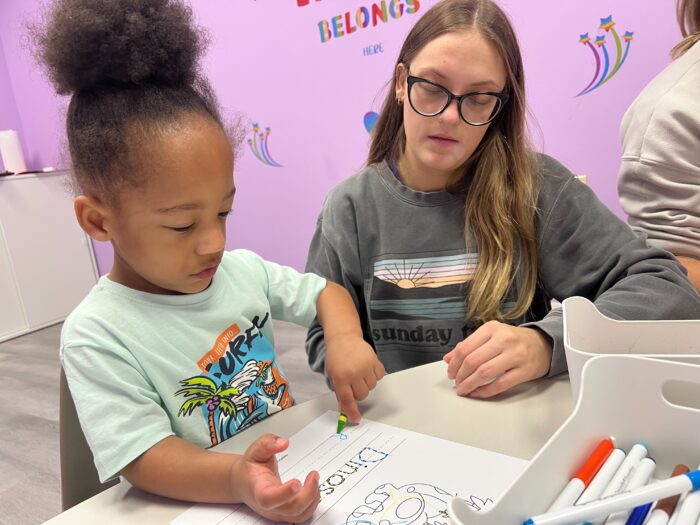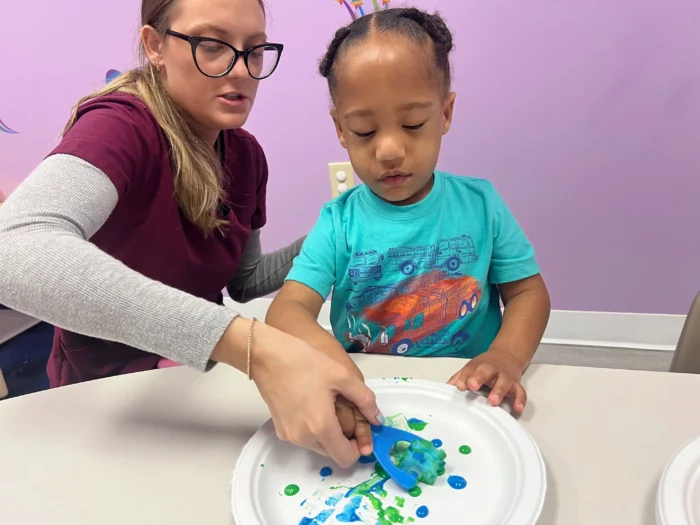
When getting ready to talk to your child about autism, feeling nervous is normal. After all, it’s an important step that should be taken properly. This guide, designed with you, parents, in mind, offers insights into how to explain autism to kids, whether they’re curious peers, caring siblings, or young ones dealing with autism themselves.
6 Foundation Strategies for Explaining Autism to Children
Before you sit down with your kid for this conversation, setting the stage can make all the difference. Here’s how you can prepare:
- See through their eyes — Remember, your child has their own view of autism. Tailor your discussion to resonate with their understanding and experiences.
- Highlight the positives — Focus on the distinct talents and viewpoints autism brings. Celebrating these differences enriches the conversation.
- Encourage curiosity — Be ready for questions or emotions. Showing you’re open to talk reinforces trust.
- Keep it simple — Use clear, everyday language to explain complex ideas.
- Visual aids help — A picture book or visual story might illustrate your points more vividly than words.
- Find a peaceful spot — A quiet, comfortable place can help your child feel at ease and more open to listening.
How to Discuss Autism with Kids On & Outside the Spectrum
Having the autism talk with children, whether they have the diagnosis or not, requires warmth, clarity, and patience. Here’s how to best approach the conversation:
Explaining ASD to Your Child With Autism
If your child is on the spectrum, introducing your child to the concept of autism is a task that should focus on affirmation and empowerment.
For example, when thinking about how to tell your child they have high-functioning autism, start the conversation by acknowledging your child’s remarkable abilities, such as their keen attention to detail or their passion for specific interests.
You can mention that autism offers them a different outlook on life and may cause them to prefer certain activities over others. Use words that affirm their value, and show them that their differences contribute positively to who they are.
You should address the challenges they might face with honesty and optimism. Assure them that facing difficulties is a part of life, and together, you will find ways through them. Explain that experiencing the world more deeply is a part of being on the spectrum, which, despite its challenges, also gifts them unique characteristics or skills and intense passions.
Here are some additional suggestions on how to explain autism to an autistic child:
- Create an “all about me” poster — Work together to create a poster showcasing their skills, interests, and achievements. This activity boosts a child’s self-esteem while visually celebrating their identity.
- Practice explaining autism to friends — Guide your child through simple dialogues they might use to describe their autism to friends. This will give them more confidence in sharing their story.
- Design a daily routine chart — Craft a chart that outlines daily routines in a visually appealing way. This tool helps in managing transitions and organizing tasks.
Explaining ASD to Their Siblings Without Autism
Explaining autism to family members, such as siblings who do not have the condition, entails explaining how their sibling’s brain functions differently than their own, making certain aspects of daily life more difficult, or simply different.
Use specific examples to make this more relatable. Emphasize how important it is to be kind and patient, and how their empathy will greatly improve their sibling’s life.
You should make it clear that love and attention aren’t limited resources. Affirm that each child’s needs and emotions are significant and deserve attention. Transparency about why their autistic sibling may require additional support helps to alleviate feelings of jealousy or neglect.
Think about these practical steps:
- Dedicate one-on-one time — To make sure every child feels appreciated, schedule special one-on-one time for them to participate in their favorite activities.
- Encourage sibling bonding activities — Find things that both siblings enjoy doing together and can participate in to foster understanding and shared experiences.
- Talk honestly about feelings — Provide a safe environment for siblings to share their thoughts and questions about autism.
- Do empathy exercises — Show empathy through both your actions and words. Simple role-playing exercises can help siblings without autism better understand their brother’s or sister’s experiences and reactions to various situations.
How to Explain Autism to Their Peers and Schoolmates
Speaking about autism to classmates and friends helps cultivate a community of kindness and acceptance around your child. Here’s how to explain autism to a child without autism:
Inform friends and classmates that autism means some individuals might interact, learn, or play in ways that are different from theirs. Mention that there are several types of autism. Explain that if someone likes quiet games or needs a little longer to answer in class, that’s just their way of experiencing the world.
Also, if possible, make sure to equip your child with clear, friendly responses to peers’ curiosity. You might also try these hands-on approaches:
- Question cards — Sit down with your child to think of questions their friends might ask about autism. Think of answers together that your child feels comfortable sharing.
- Friendship guide — Draft a simple guide with your child that lists their likes, dislikes, and how autism affects them.
- Peer buddy system — Propose a buddy system in class where students pair up to learn from each other’s strengths, including those with and without autism.
- Story sessions — Arrange for a story or book reading session in your child’s class that includes tales of diverse characters, including those with autism.
Real-Life Examples for Understanding Autism
When explaining autism to kids, weaving in real-world examples and interactive elements can demystify the subject.
Draw direct comparisons (use props if possible): “Imagine the brain as a puzzle. Everyone’s puzzle fits together in its own way. For someone with autism, some pieces might fit differently, affecting how they see the world or react to things around them. It’s like playing a video game where everyone has different abilities or power-ups.”
Highlight inspirational figures: “Did you know Satoshi Tajiri, the creator of Pokémon, has autism? His keen attention to detail and deep fascination with creatures inspired him to create a world where people can catch and train Pokémon. You see, that is how someone’s unique view of the world can create something extraordinary.” This example can also come handy when explaining autism to child peers.
Engage through visual storytelling: Grab a comic book or create a simple comic strip together where the hero navigates the day with autism superpowers, perhaps using auditory processing issues as an example. “See how our hero uses his special headphones to block out the loud noises? That helps him focus on saving the day.”
Choose Diverse Resources
- Pick stories that showcase individuals with autism thriving, like “Uniquely Wired: A Story About Autism and Its Gifts” by Julia Cook. This is a great pick if you were wondering how to explain autism to a 4 or 5 year old.
- For visual learners, select age-appropriate documentaries or animated films that feature diverse experiences of people with autism, like “The Reason I Jump.”
- Play on interactive platforms such as Sesame Street’s online resources, featuring Julia, a Muppet with autism. For older kids, organizations like Autism Speaks offer stories from other families and children with autism.
Debunking Myths and Addressing Common Questions
When kids ask about autism, use it as a chance to clear up confusion and tackle myths head-on. Whether you’re talking to children on the spectrum or explaining autism to their sibling or a class of neurotypical kids, you can start by explaining that autism makes some senses really sharp, so loud noises can be too much, and making friends might be harder because understanding social cues isn’t always easy.
It’s also important to address common misconceptions about autism. For example, it’s not rare to hear how children with autism don’t feel emotions. Make it clear that people with autism feel emotions deeply, just like anyone else.
As autism affects everyone differently, no two people with autism are the same and when a child with autism has a meltdown or tantrum, it’s not about getting their way — it’s because they’re feeling overwhelmed.
How ABA Therapy Can Help
Rooted in behavioral science, ABA therapy uses proven methods to help children with autism learn and communicate better. It gives them tools to handle everyday challenges. Family plays an important role in ABA therapy because parents, as well as children, are guided and taught how to implement various techniques.
In this context, ABA therapists work on improving communication and social skills while guiding children in framing their autism in a positive light. That will give kids confidence when it comes to explaining autism to child peers.
On a Final Note
Opening up the conversation about autism with children lays the foundation for empathy and inclusivity from a young age. It equips them with the knowledge to appreciate diversity in all its forms, including neurological differences. As parents, your role in guiding this dialogue cannot be overstated, and we hope we have managed to help you with this task.
In case you have any questions or insecurities about explaining autism to kids on or outside the spectrum, feel free to reach out to us via email, phone, or message. We’ll be happy to help you.
FAQs
How can I explain autism to a child?
There are a number of practical tips and techniques you can use. For starters, tell your child that autism means some people’s brains sort information in a special way. This can make them great at certain tasks, but it can make some ordinary actions such as chatting, maintaining eye contact, or making friends difficult.
What is the easiest way to describe autism?
Autism, in simple terms, is a developmental condition characterized by differences in social interaction, communication, and behavior. It affects how a person perceives and interacts with others, which makes certain social and sensory experiences more challenging.
How do you explain autism to classmates?
Explain that a classmate with autism might see the world in a special way. They might be great at certain things and find some social stuff tricky, just like everyone has things they’re good at and things they find difficult.



